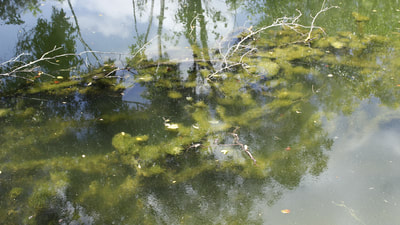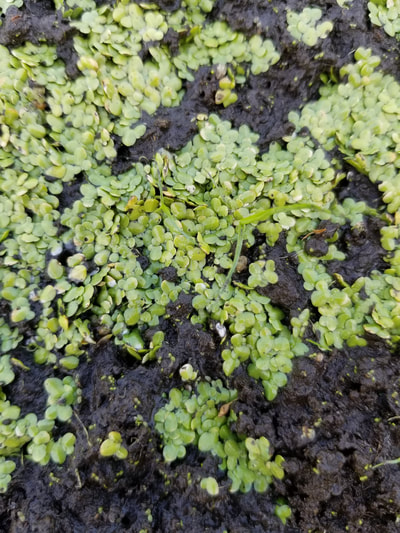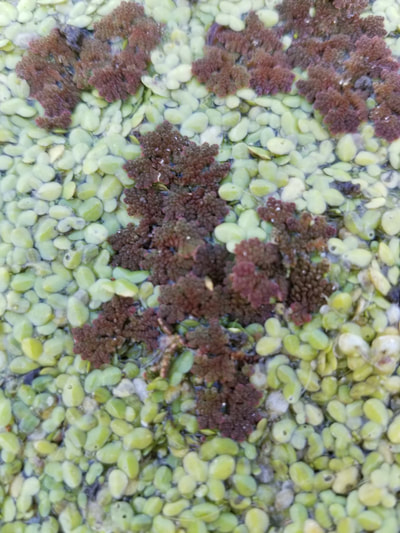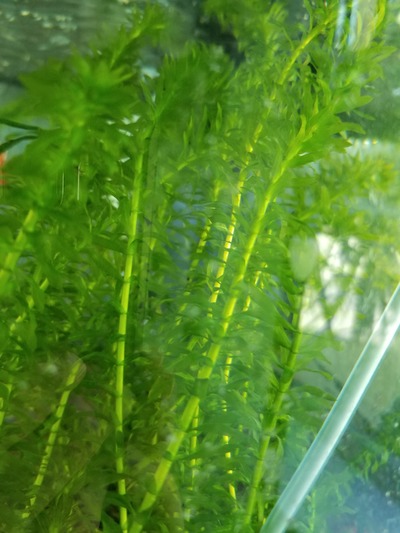ALGAE & INVASIVE PLANTS
Florida's ponds, lakes, and wetlands are crucially different than most areas in the United States - they are eutrophic or hypereutrophic, meaning they have exceptionally high levels of nutrients. States such as New York, Michigan, or Colorado have stone-lined water bodies with little organic matter, which are called oligotrophic areas. Since oligotrophic waters have very few nutrients, people often have to add fertilizer to ponds in order to establish plant communities. Florida has the opposite problem. We have such naturally high nutrient loads, exacerbated by agriculture, fertilizers, and runoff that ponds can, and often do, become overgrown with plants and algae. Traditional lake management has focused on using herbicides to kill off the plants and algae, but this has become less effective over time for the following reasons:
- Herbicides do kill plants, but they grow back resistant - requiring more or stronger herbicides.
- Decaying plants release nutrients upon death, which can flow downstream causing other algae blooms, dead zones, and aggravate Red Tide.
- Too many plants dying at once can cause fish kills as the decaying plants remove oxygen from the water.
- Herbicides can kill fish, invertebrates, and beneficial plants.
- Herbicides have a wide range of human health concerns - from carcinogenic, burning, and respiratory effects, often affecting applicators the most.
- Herbicides need to be reapplied regularly at increasing amounts, resulting in increasing costs to clients.
- When plants are killed, algae will come in to use the nutrients causing an ecosystem shift from macrophytes to algae. The same happens when algae is killed, either more algae grows to replace it or macrophytes become problematic.
INVASIVE FISH & NATIVE FISHING
Florida has over 500 non-native species causing active harm to the state's diverse landscapes and the native organisms which inhabit them. Stocking Savvy does not use any invasive species for ecosystem construction. We may temporarily encourage using University of Florida biological controls, such as Triploid Grass Carp, which are approved since they are sterile, removing aquatic vegetation without reproducing. We do not stock Tilapia, as they have non-specific and variable diets, are vulnerable to fish kills, and have been known to out-compete native fish and fisheries. Stocking Savvy will help identify invasive species in your ponds and lakes and help provide remedies. We offer free Tilapia removal and can assess other invasive fish species on a case by case basis. We have experience mitigating damage caused by Tilapia, Plecostomus (Sailfin Catfish), Various Cichlids, Clown Knifefish, and Lionfish.
Once we can control the invasive populations causing harm, Stocking Savvy will help introduce native species back into your waterways. Actually, we are the only stocking company that adds filter feeding microorganisms and herbivores to your pond! We start our restorations by planting beneficial native plants which provide habitat, mitigate shoreline erosion, and filter the water. Over time, we add larger fish, invertebrates, and even turtles to your pond! Many people assume fish, invertebrates, and microbes will just find the water on their own, or come in on birds' feet. This is a very rare circumstance, and many larger native species will never find your pond this way. Stocking Savvy uses a succession scheme informed by science, based upon various animals' reproductive patterns to build an ecosystem that will improve water quality, improve fishing, and support birds, reptiles, and native fish species. For more information on what we stock, visit our services page.
CLIMATE CHANGE, RED TIDE, AND LARGE-
SCALE ISSUES
No single person, group, community, or country can fight these large scale issues on their own. Climate Change is caused by CO2 pollution through fossil fuels, heavy industry, and deforestation. We are actively witnessing the subsequent effects, including sea level rise, harmful algal blooms, increased hurricane strength, and other massive issues across the United States of America and the world. It's not if, it's not when - it's now. Even on the ground, scientists at Stocking Savvy have noticed drops in local animal populations, fish, insects, and birds, while more Southern, warm-water fish are being found in Sarasota waters. Nuisance plant and insect outbreaks are more common and fish stocks are struggling, with catch sizes being smaller and more vulnerable every year. The foreseen changes in climate will bring warmer weather, and more intense and frequent hurricanes and heavy rains, which will wash nutrients offshore. Even Mote Marine and other prestigious marine institutes have acknowledged that, while Red Tide is naturally occurring, humans are having a major impact on its severity. Habitat loss, and the loss of animal species which filter and reduce nutrient runoff or store carbon pollution are disappearing, with harmful invasive species taking their place. So, how does an individual help fight back against these massive issues?

Red Tide event at Lido Key in Bradenton Florida 2018. This massive multiyear bloom killed millions of sharks, fish, birds, turtles, and marine mammals. Large Scale events like this are becoming more common and in addition to health and environmental concerns cost millions for local economies. Photo by Elizabeth McCatherin 2018
Every community and individual in Florida can help fight against Red Tide, Climate Change, and massive habitat loss. Below, we go into how Stocking Savvy helps our clients design plans around each problem. Though, if you're working on one, the other two go hand in hand.
- Red Tide - The most pressing issue in Florida is currently Red Tide, stemming from poor water quality and the mechanisms of Climate Change. While Climate Change has its own section below, Red Tide itself can be fought by drastically reducing phosphorous, nitrogen, and other fertilizing agents content in the water. This is Stocking Savvy's specialty! We help design plant and animal based treatments for removing algae and plants in eutrophied ponds and controlling high levels of nutrients in a biological and natural way. We also restore native animal communities at the same time ensuring there are many ecological niches for nutrients to go and multiple different organisms to eat algae, filter out nutrients and particulates, and improve water quality. We also help improve wetlands, remove invasive species, build bioswales to control runoff, and improve backyard and community grounds to improve water drainage and habitat.
- Climate Change - Renewable energy such as solar, wind, and biogas are the best ways to fight Climate Change as reducing reliance on fossil fuels is essential. Secondary ways of fighting climate change include reducing carbon already present in the atmosphere such as by planting large carbon absorbing structures, trees. Longer lived, larger trees absorb more than smaller trees or shrubs. Mitigating the effects of climate change are essential to. Planning for droughts, severe weather, sea level rise, and changing weather patterns are all issues that should be taken into account for your area when planting or building. Stocking Savvy can help design gardens that will resist or thrive in a changing climate focusing on native species.
- Habitat Loss - Our bread and butter at Stocking Savvy is helping restore habitats in a way that encourages native animals to return and improves air, water, and soil quality. Butterfly gardens, bioswales, native trees, florida friendly food crops, littoral shelf plantings, submerged pond vegetation, business front plantings, and more are all under our scope. We work with local companies and all native plants and animals for our restoration efforts to meet local needs and improve habitat.








